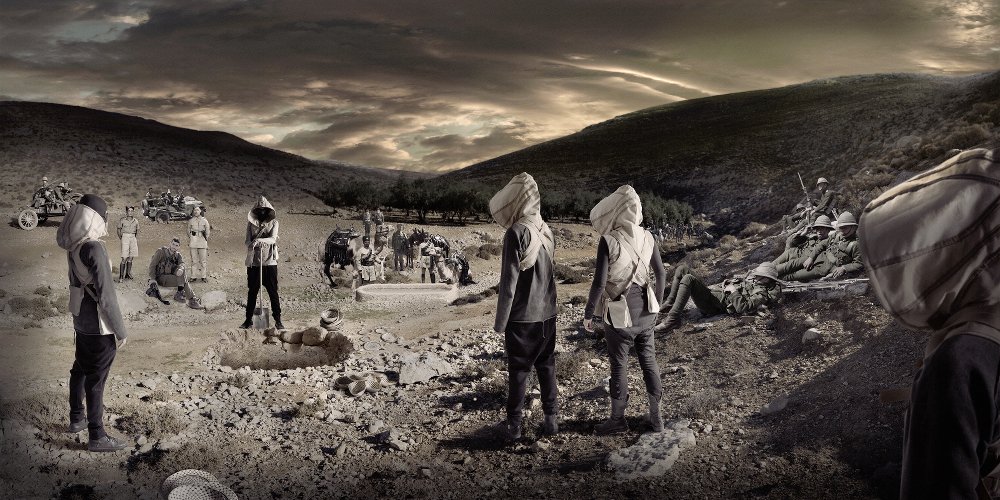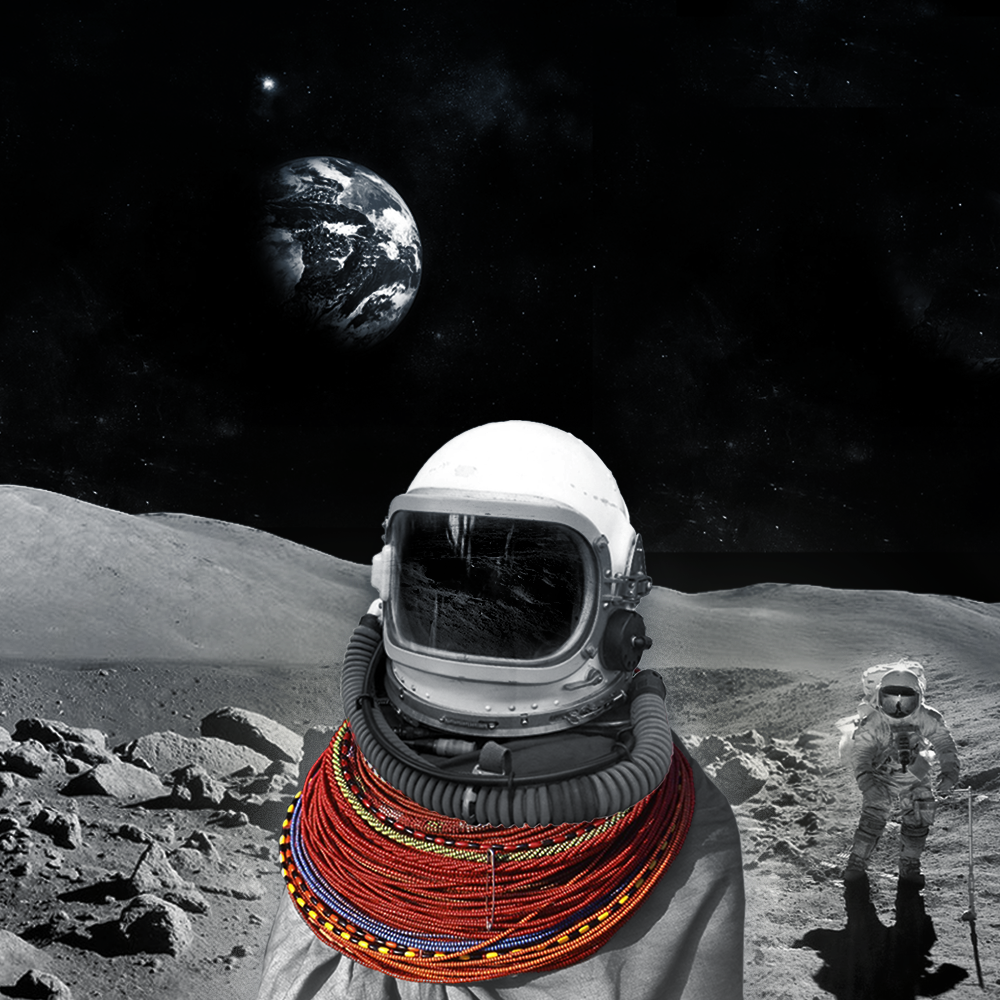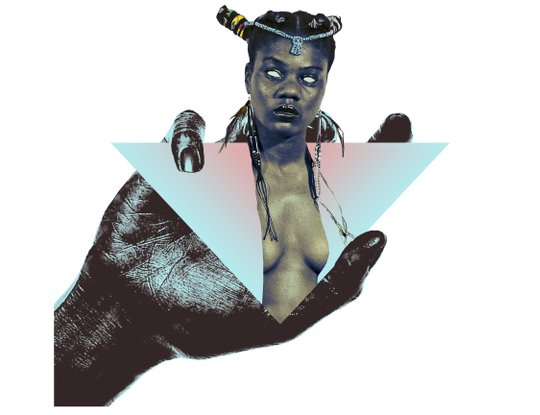Afrofuturism and the grand debate about (post) colonial, fragmented identities,stolen history and shattered dreams
Visitors to Creating Other Futures, an exhibition at De Melkweg in Amsterdam, will feelarl a sense of displacement when they are surrounded by the sound, colours and moving images during the exhibition. Fascinated by these converging elements, I was drawn to these works of art, specifically those that use different kinds of montage, like the work of Chinese artist Ming Wong. By using several different screens – tv and computer screens – her work covers the history of science fiction in China, broadcasts and interviews with the first female Chinese astronaut and Chinese science fiction art.
In the documentary Demain activist and writer Rob Hopkins says: “It’s fascinating how, as a species and as a culture, we are brilliant at imagining our own extinction and our own demise. You know, we make films about whether we are all wiped out by zombies, or nuclear bombs, or diseases, or robots, or aliens, or little funny Gremlins, all sorts of things. (...) We love those.” Hopkins wonders where the films are that show us how things are actually turn around and problems are solved. It illustrates our human capability of perfectly imagining our own destruction. What makes Creating Other Futures interesting is that in some aspects it expresses a more positive image of the future through the working of science fictional elements. By highlighting two artists in the exhibition we get to know a bit more about what Afrofuturism really is. Coming from completely different backgrounds they both focus on constructing narratives and storytelling. Musician Sun Ra, with his noted Arkestra, examines the borders of jazz music and imports other-worldly, futuristic sounds. However, more importantly, this kind of music fits into his origin story: Sun Ra claims he comes from the planet Saturn, instructed to visit earth and save the diasporic community from the harsh socio-political environment they are living in. His film Space is the place, screened at the Other Futures festival, criticises those conditions, and tells the story of Sun Ra and his efforts to establish a new black colony in space.

The term ‘Afrofuturism’ was coined by Mark Dery, whose essay ‘Black to the future’ (1994) explores the works of Afro-American science fiction writers highlighting a specific kind of narrative set in the future that touches on (post)colonial issues. Most importantly, these kinds of stories are written by people who, in one way or another, have a shared past. This focus on a common history underpins the critical approach of Søren Lind and Larissa Sansour in their short film In the future they ate from the finest porcelain. In this impressive artwork a nameless protagonist is manipulating history and the judgment from future archaeologists by burying (broken) porcelain. This act demonstrates how historiography works and what the pitfalls are. With her rebellious acts the protagonist tries to illustrate the way in which imagined communities are constructed. A bigger frame narrative is revealed: by manipulating future research, she fabricates new narratives and thus displaces the facts.
One of the underlying criticisms in the work is that the voiceless will remain voiceless. The protagonist says that fiction has a fundamental impact on history but
“Our lives are already forced upon us by fiction”
she also claims that “our lives are already forced upon us by fiction”. This also refers to the idea of an imaginary community. This approach is also one of the key basics of Afrofuturism. In one of her TED talks, Kenyan storyteller Wanuri Kahiu highlights this feature: “The struggle of man against power, is the struggle of man against forgetting [...] Because we don’t have our own history, we take Afrofuturism to stake our place in the future”. This is the process of becoming an imagined community, but with an important ‘writing back’ philosophy (or should we say ‘we are finally able to speak out’ philosophy?) hidden between the lines. Science fiction and colonialism are intertwined because questions around identity and ‘the other’ are beloved topics in Afrofuturism. Afrofuturistic works use those topics and make it their strength by creating narratives in a new, surprising idiom.
The biggest objection against Afrofuturism, is no longer an objection. In my opinion, it is important to realise that Afrofuturistic work is not only limited to publications by black and coloured artists from the African diaspora, as long as there is a shared (understanding of) history, a shared environment or a shared concern about the future and the past of African communities and societies. As long as the narrative is the main focus, we can refer to Afrofuturism, in order to join the ‘grand debate’ about colonial and post-colonial, fragmented identities, stolen history and shattered dreams. Hopkins' quote illustrates that futuristic narratives should not always be imagining the demise of the human race. The Afrofuturistic works presented in the exhibition, all share an optimistic viewpoint. The artists let the protagonists stand out while they take into account ancestral stories, spiritualism and traditions which are blended with futurism and surrealism.
MaaSci by Jacque Njeri
By using narratives, artists are reclaiming their history and their past. Such as Jacque Njeri in her series about the MaaSci, in which she re-imagines traditional Maasai in a surrealistic colour palette, surrounded by a science fictional environment. She uses a collage technique with lively colours, whose surrealistic appearance constructs alienating feelings. The visitor becomes a bystander. A voyeur of culture. A culture that might be extinct within some decades. The artwork questions the future oif the Maasai people and the lifespan of traditions. At the same time, we are looking at indigenous people who play the lead role in their own science fiction story, who take their future into their own hands. Their former exclusion from history becomes inclusion, where they did not previously have agency.

Planet Airich by Airich
Airich is a Dutch, female artist. She grew up in a family that appreciated world art, This has clearly influenced her practice. The protagonists in her work Planet Airich are black and not from this world. They are watching over us, the commoners. The portraits of these demi-gods are woven into a network of ropes, hanging on the wall. A television screen accompanies this display, which tells the viewer more about the background of these ‘nobles’. The story that Planet Airich tells is about a group of celestial outsiders, living in a parallel universe, who take care of the visible world. They are the ‘New Visionaries’. People in the real world get lost in earthly feelings and possessions. Their society praises the principles of the African Ubuntu philosophy ('be human through other human beings'), and is preaching peacefulness and pacifism. They are keeping an eye on us. We can not see them, only those with a ‘pure inner-view’ are blessed with catching a glimpse of their appearance. The godlike creatures from Planet Airich are intermediate figures, standing between their and our world. Playing the role of invisible protectors, they spread a hopeful message: They urge you to search for the truth from within. Knowing that the truth is mind-blowing as a necessity to rekindle the inner-flame, to bring about change, outlook and perspective. To know which stories are made and while trying to reveal the truth, will awaken and create a critical view on history and the will to fight for a better future.
Conclusion
We are indeed perfectly capable of imagining our future. The artists prove that every coin has two sides by creating alternate histories, while giving a voice to the voiceless and scanning problematic issues in the contemporary society. In every idea of a demise, an idea of revival and a message of hope is hidden. Provided that we, as visitor and as reader, are willing to de-construct ‘grands récits’ and join post-colonial debates while listening to the new histories and new futures that are written. We can not close our eyes to the force that lies underneath their images. Narratives are power. Power to narratives.
More information about the exhibition here.
* Laura Engels is a researcher of (South-)African literature, with a fascination for Afrofuturism and speculative fiction, Ghent University, 1994, Ghent.


